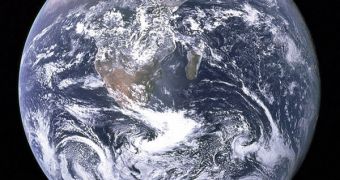In the early days of the solar system, when the Sun was still young, and the planets were racing and colliding with each other all over the place, the Earth avoided a cruel faith. According to astronomers, there was a very high possibility for the planet to fall into the new star, and, in fact, this is what should have happened. As it is now obvious, this didn't happen, and experts have no idea why we are still here. Now, a group of astronomers has managed to crack the puzzle and determine precisely what kept the young Earth going until it was “old” enough to fend for itself, Space reports.
The model appears to reveal that the planet was essentially pushed away from the Sun by massive temperature differences that existed in the area more than 4.5 billion years ago. These variations played a crucial part in our planet's survival, as the gravitational pull that the Sun exerted on the planet was tremendous. Because of this tug-of-war game, the protoplanet that would solidify to become the Earth moved farther from the Sun than where it was created, and established itself in the orbit we see today, which is perfect for supporting life. As all of you must know, we are right in the middle of our star's habitable zone.
Like all stars with planetary systems, the Sun had a protoplanetary disk around it, made up of cosmic dust and gas. From this disk, small pebbles formed from that dust that was clumping together, and then grew to become asteroids and, eventually, celestial bodies known as planetesimals. This is the earliest form of a planet. Inside the disk, experts believe that these bodies varied their orbits, changing them as they went along. However, basic physics dictates that the planetesimals should have fallen into the Sun, due to the star's enormous gravitational pull. Speaking yesterday at the 215th meeting of the American Astronomical Society (AAS), experts from the American Museum of Natural History in New York explained how we managed to escape.
What expert Mac Low and his team essentially did was develop a model that showed protoplanets could migrate, without meeting a premature death by falling into the Sun. Low explained that the things that had not been accounted for in other models were the temperature differences that were created inside the protoplanetary disks. He argued that some portions of the disks were opaque, which means that they took longer to cool, and couldn't radiate heat into space as effectively as other sections. The new model shows that planetesimals passing through these various sections of the disk would have their orbits significantly influenced.
Low and his team believe that the earliest planets could have been made to change their orbits toward the outer parts of the early solar system, rather than towards the inside, and the Sun. The scientist also revealed that outward migration might be a very widespread process, in the sense that it may have manifested itself in all planets and exoplanets we see today. Otherwise, none of them would have survived the earliest days in their respective star systems.

 14 DAY TRIAL //
14 DAY TRIAL //